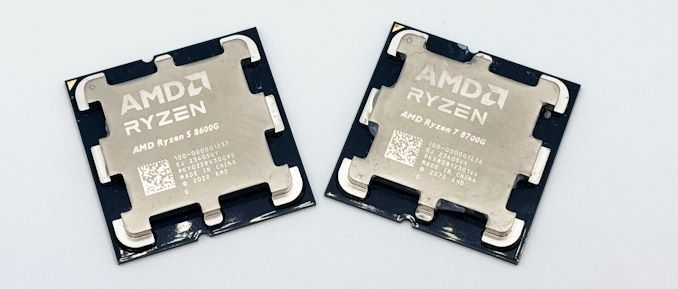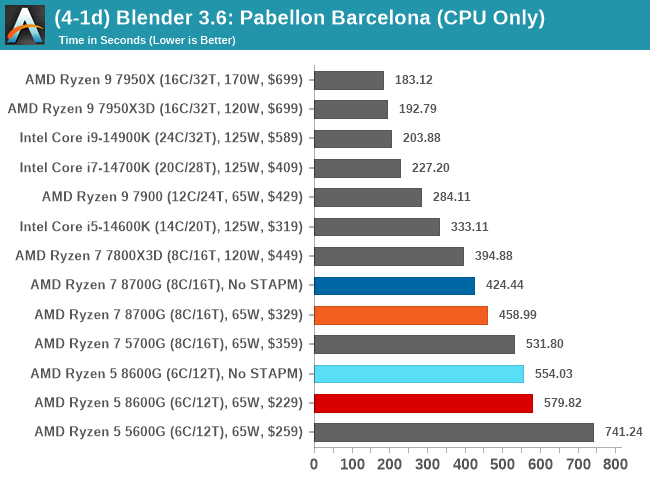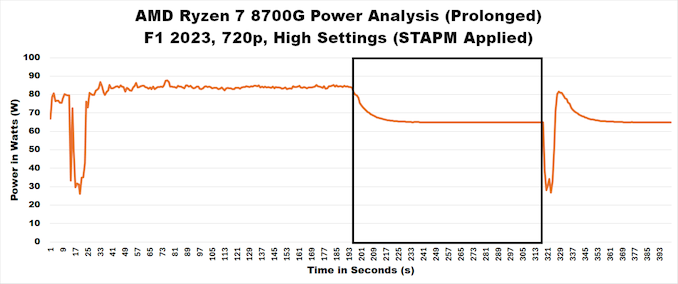AMD Fixed the STAPM Throttling Issue, So We Retested The Ryzen 7 8700G and Ryzen 5 8600G
by Gavin Bonshor on February 23, 2024 9:00 AM EST- Posted in
- CPUs
- AMD
- Phoenix
- 4nm
- AM5
- Ryzen 8000G
- Ryzen 7 8700G
- Ryzen 5 8600G
- STAPM

When we initially reviewed the latest Ryzen 8000G APUs from AMD last month, the Ryzen 7 8700G and Ryzen 5 8600G, we became aware of an issue that caused the APUs to throttle after a few minutes. This posed an issue for a couple of reasons, the first being it compromised our data to reflect the true capabilities of the processors, and the second, it highlighted an issue that AMD forgot to disable from their mobile series of Pheonix chips (Ryzen 7040) when implementing it over to the desktop.
We updated the data in our review of the Ryzen 7 8700G and Ryzen 5 8600G to reflect performance with STAPM on the initial firmware and with STAPM removed with the latest firmware. Our updated and full review can be accessed by clicking the link below:
As we highlighted in our Ryzen 8000G APU STAPM Throttling article, AMD, through AM5 motherboard vendors such as ASUS, has implemented updated firmware that removes the STAPM limitation. Just to quickly recap the Skin Temperature-Aware Power Management (STAPM) feature and what it does, AMD introduced it in 2014. STAPM itself is a feature implemented into their mobile processors. It is designed to extend the on-die power management by considering the processor's internal temperatures taken by on-chip thermal diodes and the laptop's surface temperature (i.e., the skin temperature).
The aim of STAPM is to prevent laptops from becoming uncomfortably warm for users, allowing the processor to actively throttle back its heat generation based on the thermal parameters between the chassis and the processor itself. The fundamental issue with STAPM in the case of the Ryzen 8000G APUs, including the Ryzen 7 8700G and Ryzen 5 8600G, is that these are mobile processors packaged into a format for use with the AM5 desktop platform. As a desktop platform is built into a chassis that isn't placed on a user's lap, the STAPM feature becomes irrelevant.
As we saw when we ran a gaming load over a prolonged period of time on the Ryzen 7 8700G with the firmware available at launch, we hit power throttling (STAPM) after around 3 minutes. As we can see in the above chart, power dropped from a sustained value of 83-84 W down to around 65 W, representing a drop in power of around 22%. While we know Zen 4 is a very efficient architecture at lower power values, overall performance will drop once this limit is hit. Unfortunately, AMD forgot to remove STAPM limits when transitioning Pheonix to the AM5 platform.
Retesting the same game (F1 2023) at the same settings (720p High) with the firmware highlighting that STAPM had been removed, we can see that we aren't experiencing any of the power throttling we initially saw. We can see power is sustained for over 10 minutes of testing (we did test for double this), and we saw no drops in package power, at least not from anything related to STAPM. This means for users on the latest firmware on whatever AM5 motherboard is being used, power and, ultimately, performance remain consistent with what the Ryzen 7 8700G should have been getting at launch.
The key question is, does removing the STAPM impact our initial results in our review of the Ryzen 7 8700G and Ryzen 5 8600G? And if so, by how much, or if at all? We added the new data to our review of the Ryzen 7 8700G and Ryzen 5 8600G but kept the initial results so that users can see if there are any differences in performance. Ultimately, benchmark runs are limited to the time it takes to run them, but in real-world scenarios, tasks such as video rendering and longer sustained loads are more likely to show gains in performance. After all, a drop of 22% in power is considerable, especially over a task that could take an hour.

Using one of our longer benchmarks, such as Blender 3.6, to highlight where performance gains are notable when using the latest firmware with the STAPM limitations removed, we saw an increase in performance of around 7.5% on the Ryzen 7 8700G with this removed. In the same benchmark, we saw an increase of around 4% on the Ryzen 5 8600G APU.
Over all of the Blender 3.6 tests in the rendering section of our CPU performance suite, performance gains hovered between 2 and 4.4% on the Ryzen 5 8600G, and between 5 and 7.5% on the Ryzen 8700G, which isn't really free performance, it's the performance that should have been there to begin with at launch.

Looking at how STAPM affected our initial data, we can see that the difference in World of Tanks at 768p Minumum settings had a marginal effect at best through STAPM by around 1%. Given how CPU-intensive World of Tanks is, and combining this with integrated graphics, the AMD Ryzen APUs (5000G and 8000G) both shine compared to Intel's integrated UHD graphics in gaming. Given that gaming benchmarks are typically time-limited runs, it's harder to identify performance gains. The key to takeaway here is that with the STAPM limitation removed, the performance shouldn't drop over sustained periods of time, so our figures above and our updated review data aren't compromised.

Regarding gaming with a discrete graphics card, we saw no drastic changes in performance, as highlighted by our Total War Warhammer 3 at 1440p Ultra benchmark. Across the board, in our discrete graphics results with both the Ryzen 7 8700G and the Ryzen 5 8600G, we saw nothing but marginal differences in performance (less than 1%). As we've mentioned, removing the STAPM limitations doesn't necessarily improve performance. Still, it allows the APUs to keep the same performance level for sustained periods, which is how it should have been at launch. With STAPM applied as with the initial firmware at launch on AM5 motherboards, power would drop by around 22%, limiting the full performance capability over prolonged periods.
As we've mentioned, we have updated our full review of the AMD Ryzen 7 8700G and Ryzen 5 8600G APUs to reflect our latest data gathered from testing on the latest firmware. Still, we can fully confirm that the STAPM issue has been fixed and that the performance is as it should be on both chips.
You can access all of our updated data in our review of the Ryzen 7 8700G and Ryzen 5 8600G by clicking the link below.












7 Comments
View All Comments
haplo602 - Friday, February 23, 2024 - link
Just out of curiosity, how long does the WoT benchmark run ? For Blender we can see that directly in the result but I doubt the WoT test is at least 3 minutes long, so how many runs did you do back to back with STAPM and without STAPM ?Gavin Bonshor - Friday, February 23, 2024 - link
I personally run gaming tests three times and average the results out. It takes longer to get the data, but we can pinpoint anomalies.Regarding the time the WoT benchmark takes to run, I would have to time it once I've finished testing what's on the test bench. I'm currently at the hospital, so I won't be able to check until I get back. The WoT benchmark did show gains with STAPM disabled, but this test is usually very sensitive to frequency and cores. I'll get back to you when I can.
SaolDan - Friday, February 23, 2024 - link
Sorry to hear you are at the hospital.Orfosaurio - Sunday, February 25, 2024 - link
Are you better now?FWhitTrampoline - Friday, February 23, 2024 - link
But can I Blender 3D Cycles(GPU accelerated and not CPU) render on the Radeon Integrated Graphics? So does AMD currently support Blender 3D Cycles rendering on its Radeon Integrated Graphics? And Blender 3D uses CPU Cycles rendering as a fallback if Blender can not detect any GPUs that are Cycles GPU Rendering capable installed on the system.Intel's got no iGPU issues with Blender 3D using Intel's OneAPI/Level-0 while AMD's ROCm/HIP is currently unsupported for Radeon iGPUs, and that's According to Phoronix. And on GPUs Cycles rendering is a GPU Compute workload(Ray Tracing/BVH calculations math accelerated on GPU shader cores or RT cores) and Blender 3D no longer utilizes OpenCL as the Compute API for iGPU/dGPUs ever since Blender 3.0 was released!
PeachNCream - Sunday, February 25, 2024 - link
For the TL;DR folks - its less than 1% difference so there was no reason to get excited to begin withmeacupla - Tuesday, February 27, 2024 - link
I wonder if mini-PCs running 7840HS, etc. can benefit from this same fix. That is unless the maker already implemented a workaround.